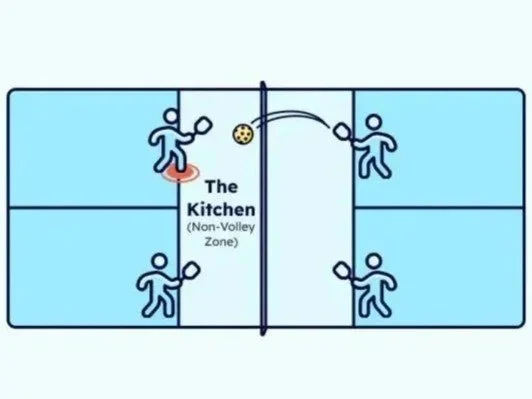Why Is the Pickleball Kitchen Called "Kitchen"?
The "kitchen" in pickleball refers to the Non-Volley Zone (NVZ), a 7-foot area on either side of the net where players are strictly not allowed to volley the ball. For every player aiming to move beyond the beginner level, mastering play in and around the kitchen is essential.
The Quirky Origin of the Term "Kitchen"
Before diving into strategy, it's worth exploring the name itself. The origin of the term "kitchen" is one of pickleball’s enduring and playful mysteries, with several popular theories adding to the sport's charm:
The Shuffleboard Connection: The most widely accepted theory is that the term was borrowed from shuffleboard. In that game, the "kitchen" is a penalty area near the end of the board that affects scoring. In pickleball, the NVZ similarly acts as a penalty zone, forbidding the aggressive volley and dictating specific play.
The Finesse Theory: Another popular explanation is that playing in the kitchen requires finesse and care, much like working in a real kitchen where precision, delicacy, and soft touches (dinks) are important.
Pickleball's Informal Culture: The name also perfectly fits with the relaxed, informal, and humorous naming style common in pickleball’s early culture, which sought to make the sport accessible and fun.
Source: Pickleheads
What Makes the Kitchen Special? The Rules
The Non-Volley Zone puts a unique, game-defining twist on pickleball rules that separates it from tennis or badminton:
The No-Volley Rule: Players cannot hit a volley (hitting the ball out of the air before it bounces) while they are standing inside the kitchen. Critically, it is also a fault if a player's momentum carries them into or touches the zone after hitting a volley. This rule prevents aggressive, over-the-net spiking and forces a strategic reset.
The Bounce Exemption: Players are allowed to enter the kitchen to hit balls that have already bounced. This rule is what enables the use of soft, controlled “dink” shots and tactical scrambles.
How to Master Play in the Kitchen
Mastering the kitchen unlocks the crucial short-game element of pickleball strategy. The team that gets to and dominates the kitchen line usually wins the point.
1. Perfect Your Dinking
The dink shot is a soft, precise stroke that lands just over the net and into your opponent’s kitchen.
Aim: Keep it low, just inches over the net, and force your opponent to hit up on the ball.
Consistency: Focus on repetition and control over power. The purpose is to slow the game down and create opportunities for your opponents to make an error or pop the ball up.
2. Utilize Precise Footwork and Positioning
Your feet are your biggest risk of faulting at the kitchen line.
Stay Behind the Line: Always maintain the ready position just behind the kitchen line while waiting for a volley.
Lateral Movement: Use quick, balanced lateral shuffles to move side-to-side, ensuring you don't accidentally step on or over the line when reaching for a ball.
3. Cultivate Mental Discipline
The kitchen is a test of patience.
Avoid the Attack Temptation: Resist the urge to smash the ball unless an opponent’s shot pops up high above the net. Patience is key to waiting for the right moment to attack.
The "Reset": If you are forced back, focus on hitting a "reset" shot. This is a soft stroke that lands in the kitchen, giving you time to recover and return to the NVZ line.
4. Transition Effectively
Pickleball is a game of transition, moving from the baseline to the NVZ.
The Third Shot Drop: Use the third shot drop to buy time to safely reach the kitchen line after the serve and return. Once established, you can effectively engage in the fast-paced dink exchange and maintain offensive pressure.
Final Thoughts
The "kitchen" is both a quirky namesake and a highly strategic zone that demands skill, precision, and mental sharpness. Understanding its unique rules and developing mastery over play in and around this zone can elevate one's pickleball game significantly, turning a casual player into a confident competitor.

